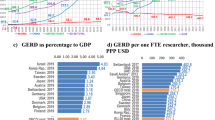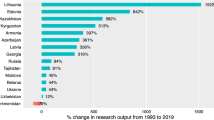Abstract
Against the common view that scientific output in peripheral and non-English speaking countries is largely underrepresented inScience Citation Index (SCI), this study shows that academic Brazilian scientists in chemistry and electrical engineering tend to publish in “good” international journals covered bySCI. The rate of citations they earn, however, looks rather poor. The reasons why Brazilian scientists publish in foreign journals are analysed and the policy of encouraging scientists to publish their best contributions abroad is questioned.
Similar content being viewed by others
References
See, among others, the works ofArunachalam andMoravcsik — some of them reported below — and ofCastro, Schwartzman andVelho as regards Brazil.
M. Moravcsik,The Scientist, April 20 (1987) 11.
E. Garfield, Mapping science in the Third World,Science and Public Policy, 10 (1983) 112.
C.M. Castro,Ciência e Universidade, Jorge Zahar Editor, Rio de Janeiro, 1985, p. 72.
J.D. Frame, Mainstream research in Latin America and the Caribbean,Interciencia, 2 (1977) 143.
C.M. Castro, Ha producao cientifica no Brazil?Ciência e Cultura (suplemento), 37 (1985) 165.
C.M. Castro,. note 4, p. 60 reports that in 1982 Brazilian scientists published 7.968 journal articles, 5.995 (75%) in national journals.
M.J. Moravcsik,Strengthening the Coverage of Third World Science — The final report of the Philadelphia workshop and the discussions preceding and following that workshop — July 1985, p. 10.
L. Velho, The author and the beholder. How paradigm commitments can influence the interpretation of research results,Scientometrics, 11 (1987) 59.
M.J. Moravcsik, In the beholder's eye: possible reinterpretation of Velho's results on Brazilian agricultural research,Scientometrics, 11 (1987) 53.
C.M. Castro, note 6, p. 171. See alsoS. Schwartzman, Coming full circle: a reappraisal of university research in Latin America,Minerva, 24 (1986) 456.
L. Velho, The “meaning” of citation in the context of a sciencifically peripheral country,Scientometrics, 9 (1986) 71.
SeeM.A.H. Cagnin, Patterns of research in chemistry in Brazil,Interciencia, 10 (1985) 64-77;L. Velho, op. cit.The author and the beholder. How paradigm commitments can influence the interpretation of research results,Scientometrics, 11 (1987) 59. note 9;C.M. Castro, op. cit. Ha producao cientifica no Brazil?Ciência e Cultura (suplemento), 37 (1985) 165. note 6.
C.M. Castro,Ciência e Cultura (suplemento), 37 (1985) note 6, p. 179. However, considering that interdisciplinary journals and several others were reported in more than one list, 300 journals seems to be a more realistic estimate.
They are — according to the 1987 edition ofSCI andSSCI — Anais da Academia Brasileira de Ciências, Brazilian Journal of Medical and Biological Research, Revista do Instituto de Medicina Tropical de Sao Paulo; and, respectively,Arquivos Brasileiros de Psicologia, Dados — Revista de Ciências Sociais, Revista de Saude Publica. It should be noted that in previous editions four Brazilian journals were scanned both inSCI and inSSCI.
L. Velho, note 12, p. 73.
According toMoravcsik (op. cit.Strengthening the Coverage of Third World Science — The final report of the Philadelphia workshop and the discussions preceding and following that workshop — July 1985, note 8, p. 9.), the number of serial in natural sciences in existence around the world is estimated to be between 50000 and 70000.
The “impact factor” published in theJournal Citation Reports (JCR) by ISI — is a measure based on the average number of citations received by articles published in a journal during a specific time period.
Since theJCR impact factor of periodicals often varies from year to year, it is advisable to average it over a period of time. For this study, I have used a three-year average (1983–85) — roughly encompassing the period in which the papers analysed were published an cited.
SeeE. Garfield, The most cited papers in chemistry,Current Contents, 19 (1988) No. 38, pp. 4–5.
See, for instance, the articles of four critics toB. Martin andJ. Irvine's work and their reply published inSocial Studies of Science, 15 (1985) 525–575. For a good summary of this controversy, see alsoB. Cronin,The Citation Process, Taylor Graham, London, 1984.
T. Braun, W. Glänzel, A. Schubert, World flash on basic research. The newest version of the facts and figures on publication output and relative citation impact in the life science and chemistry 1981–1985,Scientometrics, 14 (1988) 3.
The observed citation rate for Austria, for instance, was 2.20; Finland, 2.27; Italy, 2.48; Japan, 2.56; France, 2.73. Switzerland was at the top of the ranking with a rate of 4.42.
B.R. Martin, J. Irvine, Assessing basic research: some partial indicators of scientific progress in radio astronomy,Research Policy, 12 (1983) 61.P. Vinkler, Evaluation of some methods for the relative assessment of scientific publications,Scientometrics, 10 (1986) 157.L. Velho, op.cit. note 12.
Similar results were found byL. Velho, note 12, p. 80.
Braun et al.. note 22. It is interesting to know that the most cited 1984 chemistry paper received 108 citations between 1984 and 1986; and the 98 most cited papers were cited, on average, 49.2 times (SeeE. Garfield,. note 20).
H.F. Moed et al., The use of bibliometric data for the measurement of university research performance,Research Policy, 14 (1985) 131.
SeeS. Arunachalam, K. Manorama, How do journals on the periphery compare with mainstream scientific journals?Scientometrics, 14 (1988) 83.
S. Schwartzman, A politica brasileira de publicacoes cientificas e tecnicas: reflexoes,Revista Brasileira de Tecnologia, 15 (1984) 25–32, p. 28.
Obviously, I am not referring to the page charges that many journals levy and which are generally paid by governmental agencies.
With a greater number of good journals, one might also expect a better coverage in the ISI database.
It is quite revealing to look at the number of journals indexed by ISI (many of them in English) existing in small developed countries; although Netherlands, Switzerland and Denmark-respectively with 275, 115 and 47 journals — should be considered exceptions.
S. Schwartzman,Foreigners in their country: three generations of Brazilian scientists. Paper presented at Society for Social Studies of Science Conference, Washington D.C., November 2–4, 1979.
Author information
Authors and Affiliations
Rights and permissions
About this article
Cite this article
Spagnolo, F. Brazilian scientists' publications and mainstream science: Some policy implications. Scientometrics 18, 205–218 (1990). https://doi.org/10.1007/BF02017762
Received:
Issue Date:
DOI: https://doi.org/10.1007/BF02017762




